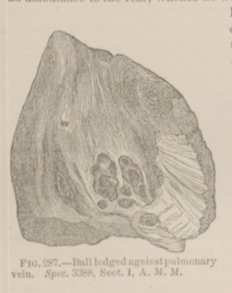Title: P——, Allman M.
Source text: Surgeon General Joseph K. Barnes, United States Army, The Medical and Surgical History of the War of the Rebellion. (1861–65.), Part 1, Volume 2 (Washington, D.C.: Government Printing Office, 1870), 588.
Civil War Washington ID: med.d1e20323
TEI/XML: med.d1e20323.xml
CASE 17.—Private Allman M. P——, Co. C, 34th Virginia Regiment, aged 35 years, was wounded at Hatcher's Run, October 27th, 1864, and made a prisoner. He was taken to the field hospital of the 1st division of the Second Corps, where Surgeon William Vosburg, 111th New York Volunteers, noted the case (one of penetrating wound of the chest) and applied the necessary dressings, and administered restoratives, and, when the patient had rallied from the shock of the injury, sent him in an ambulance to the rear, whence he was conveyed on a hospital steamer to Washington, where he was admitted to Columbian Hospital, Washington, October 30th, 1864, with a "gunshot penetrating wound of the chest, received at Petersburg, Virginia, on the 27th. A minié ball entered the triangle of the neck, passed downward into the chest, fractured the first rib and partially the clavicle, and slightly injured the apex of the left lung." Acting Assistant Surgeon C. F. Lloyd, in charge of the ward, treated the case mainly on the expectant plan, with careful nursing, and palliative remedies to meet symptoms. The ball was out of reach, and Surgeon T. R. Crosby, U. S. V., in charge of the hospital, decided that an attempt to extract it was unwarrantable, as was clearly proved in the sequel. The patient suffered greatly from oppressed breathing and the usual complications of traumatic pleuro-pneumonia, especially from frequent painful cough. Concentrated sustaining nourishment was given, but the patient steadily grew worse, and death resulted on November 11th, 1864, from intermediary hæmorrhage. The necropsy showed rigor mortis great. Old pleuritic and diaphragmatic adhesions existed on the left side of the chest. There were about four ounces of clotted blood on the walls of the chest near the wound. The upper lobe of the left lung was atrophied and almost gangrenous in appearance. The adjoining wood cut (FIG. 287) shows a wet preparation of the upper half of the left lung, with a conoidal ball embedded in its substance, partially blocking up the left pulmonary vein. It was contributed, with a memorandum of the case, by Acting Assistant Surgeon J. Fischer. After the specimen had been hardened in alcohol, upon tracing the track of the wound from its entrance in the pleura at the posterior part of the upper lobe of the left lung, near the apex, downward and forward to the root of the lung, the larger of the two missiles figured in the wood-cut (FIG. 288) was found lying against the common trunk formed by the junction, in this case, of the two left pulmonary veins. There was a small jagged opening in the vein, whether produced mechanically after death, or by ulceration, could not be determined. The track of the wound was filled with coagula. Near by the larger missile, lying against the fibrous cord constituted by the remains of the ductus arteriosus was found a smaller misshapen fragmentary projectile, apparently a portion of a carbine ball. It was difficult to account for its presence, which had not been remarked in the examination of the specimen in its recent state. It had apparently entered through the same track as the larger missile, a track that was large and much lacerated. It is hardly possible that it could have been introduced post-mortem to freight the preparation, which submerged in alcohol by its own density. It was not a fragment of the larger ball, which, though battered and flattened by impact on the first rib, was entire and weighed 540 grains. Its presence in the already perplexing specimen was very puzzling.

